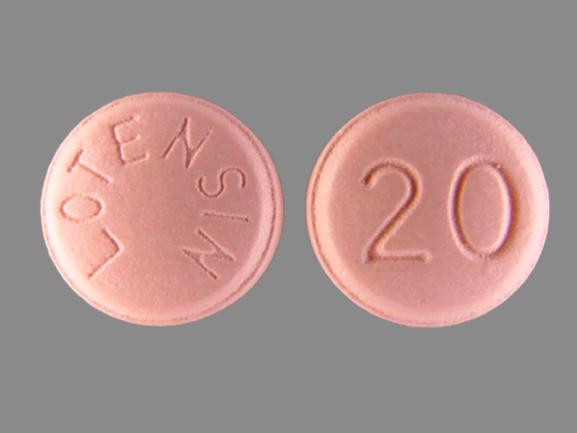Lotensin Dosage
Generic name: BENAZEPRIL HYDROCHLORIDE 20mg
Dosage form: tablet
Drug class: Angiotensin Converting Enzyme Inhibitors
Medically reviewed by Drugs.com. Last updated on Jan 13, 2025.
2.1 Recommended Dosage
ADULTS
The recommended initial dose for patients not receiving a diuretic is 10 mg once a day. The usual maintenance dosage range is 20 to 40 mg per day administered as a single dose or in two equally divided doses. A dose of 80 mg gives an increased response, but experience with this dose is limited. The divided regimen was more effective in controlling trough (pre-dosing) blood pressure than the same dose given as a once-daily regimen.
Use with diuretics in adults
The recommended starting dose of Lotensin in a patient on a diuretic is 5 mg once daily. If blood pressure is not controlled with Lotensin alone, a low dose of diuretic may be added.
PEDIATRIC PATIENTS 6 YEARS OF AGE AND OLDER
The recommended starting dose for pediatric patients is 0.2 mg/kg once per day. Titrate as needed to 0.6 mg/kg once per day. Doses above 0.6 mg/kg (or in excess of 40 mg daily) have not been studied in pediatric patients.
Lotensin is not recommended in pediatric patients less than 6 years of age or in pediatric patients with GFR less than 30 mL/min/1.73m².
2.2 Dose Adjustment for Renal Impairment
For adults with a GFR <30 mL/min/1.73 m² (serum creatinine >3 mg/dL), the recommended initial dose is 5 mg Lotensin once daily. Dosage may be titrated upward until blood pressure is controlled or to a maximum total daily dose of 40 mg. Lotensin can also worsen renal function.
2.3 Preparation of Suspension (for 150 mL of a 2 mg/mL Suspension)
Add 75 mL of Ora-Plus®* oral suspending vehicle to an amber polyethylene terephthalate (PET) bottle containing fifteen Lotensin 20 mg tablets, and shake for at least two minutes. Allow the suspension to stand for a minimum of 1 hour. After the standing time, shake the suspension for a minimum of one additional minute. Add 75 mL of Ora-Sweet®* oral syrup vehicle to the bottle and shake the suspension to disperse the ingredients. The suspension should be refrigerated at 2º to 8°C (36º to 46°F) and can be stored for up to 30 days in the PET bottle with a child-resistant screw- cap closure. Shake the suspension before each use.
*Ora-Plus® and Ora-Sweet® are registered trademarks of Paddock Laboratories, Inc. Ora Plus® contains carrageenan, citric acid, methylparaben, microcrystalline cellulose, carboxymethylcellulose sodium, potassium sorbate, simethicone, sodium phosphate monobasic, xanthan gum, and water. Ora-Sweet® contains citric acid, berry citrus flavorant, glycerin, methylparaben, potassium sorbate, sodium phosphate monobasic, sorbitol, sucrose, and water.
Frequently asked questions
More about Lotensin (benazepril)
- Check interactions
- Compare alternatives
- Reviews (5)
- Drug images
- Side effects
- Patient tips
- During pregnancy
- Generic availability
- Drug class: Angiotensin Converting Enzyme Inhibitors
- Breastfeeding
- En español
Patient resources
Professional resources
Other formulations
Related treatment guides
See also:
Further information
Always consult your healthcare provider to ensure the information displayed on this page applies to your personal circumstances.


